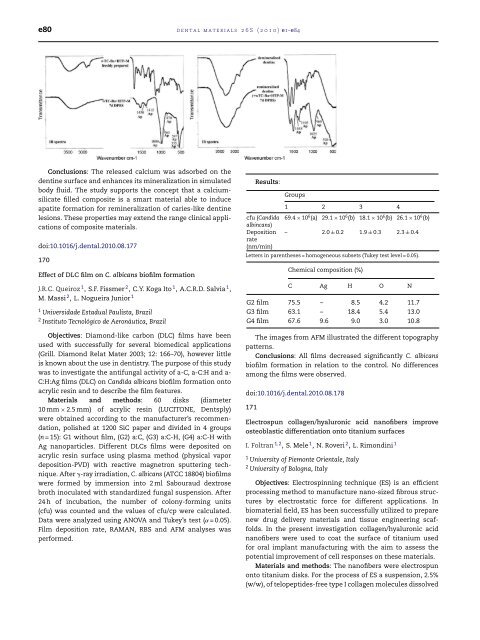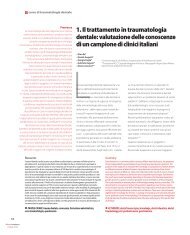Abstracts of the Academy of Dental Materials Annual ... - IsiRed
Abstracts of the Academy of Dental Materials Annual ... - IsiRed
Abstracts of the Academy of Dental Materials Annual ... - IsiRed
Create successful ePaper yourself
Turn your PDF publications into a flip-book with our unique Google optimized e-Paper software.
e80 dental materials 26S (2010) e1–e84<br />
Conclusions: The released calcium was adsorbed on <strong>the</strong><br />
dentine surface and enhances its mineralization in simulated<br />
body fluid. The study supports <strong>the</strong> concept that a calciumsilicate<br />
filled composite is a smart material able to induce<br />
apatite formation for remineralization <strong>of</strong> caries-like dentine<br />
lesions. These properties may extend <strong>the</strong> range clinical applications<br />
<strong>of</strong> composite materials.<br />
doi:10.1016/j.dental.2010.08.177<br />
170<br />
Effect <strong>of</strong> DLC film on C. albicans bi<strong>of</strong>ilm formation<br />
J.R.C. Queiroz 1 , S.F. Fissmer 2 , C.Y. Koga Ito 1 , A.C.R.D. Salvia 1 ,<br />
M. Massi 2 , L. Nogueira Junior 1<br />
1 Universidade Estadual Paulista, Brazil<br />
2 Instituto Tecnológico de Aeronáutica, Brazil<br />
Objectives: Diamond-like carbon (DLC) films have been<br />
used with successfully for several biomedical applications<br />
(Grill. Diamond Relat Mater 2003; 12: 166–70), however little<br />
is known about <strong>the</strong> use in dentistry. The purpose <strong>of</strong> this study<br />
was to investigate <strong>the</strong> antifungal activity <strong>of</strong> a-C, a-C:H and a-<br />
C:H:Ag films (DLC) on Candida albicans bi<strong>of</strong>ilm formation onto<br />
acrylic resin and to describe <strong>the</strong> film features.<br />
<strong>Materials</strong> and methods: 60 disks (diameter<br />
10 mm × 2.5 mm) <strong>of</strong> acrylic resin (LUCITONE, Dentsply)<br />
were obtained according to <strong>the</strong> manufacturer’s recommendation,<br />
polished at 1200 SiC paper and divided in 4 groups<br />
(n = 15): G1 without film, (G2) a:C, (G3) a:C-H, (G4) a:C-H with<br />
Ag nanoparticles. Different DLCs films were deposited on<br />
acrylic resin surface using plasma method (physical vapor<br />
deposition-PVD) with reactive magnetron sputtering technique.<br />
After �-ray irradiation, C. albicans (ATCC 18804) bi<strong>of</strong>ilms<br />
were formed by immersion into 2 ml Sabouraud dextrose<br />
broth inoculated with standardized fungal suspension. After<br />
24 h <strong>of</strong> incubation, <strong>the</strong> number <strong>of</strong> colony-forming units<br />
(cfu) was counted and <strong>the</strong> values <strong>of</strong> cfu/cp were calculated.<br />
Data were analyzed using ANOVA and Tukey’s test (˛ = 0.05).<br />
Film deposition rate, RAMAN, RBS and AFM analyses was<br />
performed.<br />
Results:<br />
Groups<br />
1 2 3 4<br />
cfu (Candida<br />
albincans)<br />
69.4 × 106 (a) 29.1 × 106 (b) 18.1 × 106 (b) 26.1 × 106 (b)<br />
Deposition<br />
rate<br />
(nm/min)<br />
– 2.0 ± 0.2 1.9 ± 0.3 2.3 ± 0.4<br />
Letters in paren<strong>the</strong>ses = homogeneous subsets (Tukey test level = 0.05).<br />
Chemical composition (%)<br />
C Ag H O N<br />
G2 film 75.5 – 8.5 4.2 11.7<br />
G3 film 63.1 – 18.4 5.4 13.0<br />
G4 film 67.6 9.6 9.0 3.0 10.8<br />
The images from AFM illustrated <strong>the</strong> different topography<br />
patterns.<br />
Conclusions: All films decreased significantly C. albicans<br />
bi<strong>of</strong>ilm formation in relation to <strong>the</strong> control. No differences<br />
among <strong>the</strong> films were observed.<br />
doi:10.1016/j.dental.2010.08.178<br />
171<br />
Electrospun collagen/hyaluronic acid nan<strong>of</strong>ibers improve<br />
osteoblastic differentiation onto titanium surfaces<br />
I. Foltran 1,2 , S. Mele 1 , N. Roveri 2 , L. Rimondini 1<br />
1 University <strong>of</strong> Piemonte Orientale, Italy<br />
2 University <strong>of</strong> Bologna, Italy<br />
Objectives: Electrospinning technique (ES) is an efficient<br />
processing method to manufacture nano-sized fibrous structures<br />
by electrostatic force for different applications. In<br />
biomaterial field, ES has been successfully utilized to prepare<br />
new drug delivery materials and tissue engineering scaffolds.<br />
In <strong>the</strong> present investigation collagen/hyaluronic acid<br />
nan<strong>of</strong>ibers were used to coat <strong>the</strong> surface <strong>of</strong> titanium used<br />
for oral implant manufacturing with <strong>the</strong> aim to assess <strong>the</strong><br />
potential improvement <strong>of</strong> cell responses on <strong>the</strong>se materials.<br />
<strong>Materials</strong> and methods: The nan<strong>of</strong>ibers were electrospun<br />
onto titanium disks. For <strong>the</strong> process <strong>of</strong> ES a suspension, 2.5%<br />
(w/w), <strong>of</strong> telopeptides-free type I collagen molecules dissolved



